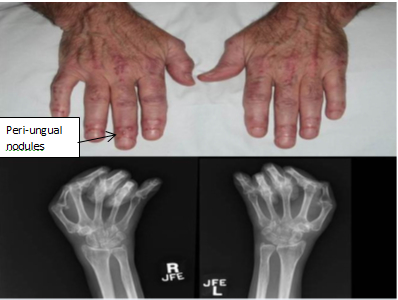Session Information
Date: Wednesday, October 24, 2018
Title: 6W021 ACR Abstract: Misc Rheumatic & Inflam DZ II (2970–2975)
Session Type: ACR Concurrent Abstract Session
Session Time: 11:00AM-12:30PM
Background/Purpose: Multicentric reticulohistiocytosis (MRH) is a systemic disease characterized by papulo-nodular skin eruptions and progressive, deforming arthritis. We aimed to examine the clinical correlates and outcomes of MRH seen at our center, and study the association with malignancy and autoimmunity.
Methods: A retrospective cohort of MRH patients treated at our institution from 01/01/1980 to 04/30/2017 was assembled. Demographics, clinical features, laboratory tests, imaging findings, histopathology (HP), treatments and outcomes were abstracted. Autoimmune (AI) disorders and malignancies before and after MRH diagnosis were collected.
Results: We identified 24 patients with MRH (58% female, 75% Caucasian, mean age at diagnosis 52y) with median follow up of 2.3 y. All patients had confirmed diagnosis by HP (23 skin, 7 synovial) and had cutaneous & articular involvement. Nodular skin lesions were noted in 96% patients (periungual area & dorsal hand in 87%, periarticular 61%, face 54%, arms 42%, back 29%, neck 21%, legs 21%, ears 12%, scalp 12%) and mucosal nodules in 30% patients. 92% patients had arthralgia, 88% had joint swelling, and 54% had synovitis. Frequency of joint involvement was upper extremity (UE) PIP(29%)> UE DIPs, MCPs, wrist>MTPs, Toes>Knees>Elbows. Radiographic erosions were noted in 67% patients. Constitutional symptoms included fatigue(15), unintentional weight loss(10),lymphadenopathy(4) and pruritis(11). Systemic features included dysphagia(5), photosensitivity(4), dry eyes(3), and serositis(3). Several patients had positive serologies: ANA(8), RF(5), CCP(3), SSA(3), SSB(2), dsDNA(1). A third of patients had concomitant AI disorders(RA[3], SS[1], chronic focal granulomatous nephritis[1], JIA[1], psoriasis[1], myasthenia gravis and ITP[1]) and 1/3rd had malignancy(melanoma{3], basal cell carcinoma[2], and 1 each with ovarian carcinoma, squamous cell carcinoma lung, peritoneal adenocarcinoma, and endometrial carcinoma). Most patients were treated with systemic CS(15) and DMARDs(13): MTX(8), CYC(10), chlorambucil(2) and CSA(1). Biologics (infliximab, etanercept, adalimumab) were used in 4 patients. 2 patients had complete resolution of symptoms, while majority showed only partial improvement. 10 patients developed joint deformities involving: wrist(4), MCP(4), PIP(7), DIP(4), MTP(3), and knee(2). None had arthritis mutilans. 75% were alive at last follow up.
Conclusion: To our knowledge, this is the largest series of MRH patients from a single institution, highlighting the rarity of the condition, and an unmet need for treatment options that can allow sustained disease remission. We emphasize the need for HP to distinguish it from mimicking rheumatic conditions and initiating early aggressive treatment to potentially prevent deforming arthritis. A high vigilance for malignancy and other AI diseases is necessary.
To cite this abstract in AMA style:
Sandhu AS, Crowson CS, Wetter D, McKenzie G, Makol A. Multicentric Reticulohistiocytosis (1980-2017): A Rare Disease, Commonly Associated with Malignancy and Autoimmunity [abstract]. Arthritis Rheumatol. 2018; 70 (suppl 9). https://acrabstracts.org/abstract/multicentric-reticulohistiocytosis-1980-2017-a-rare-disease-commonly-associated-with-malignancy-and-autoimmunity/. Accessed .« Back to 2018 ACR/ARHP Annual Meeting
ACR Meeting Abstracts - https://acrabstracts.org/abstract/multicentric-reticulohistiocytosis-1980-2017-a-rare-disease-commonly-associated-with-malignancy-and-autoimmunity/

